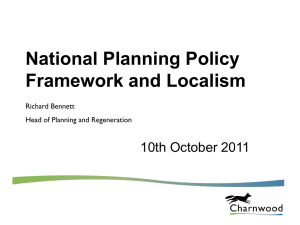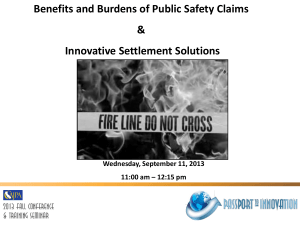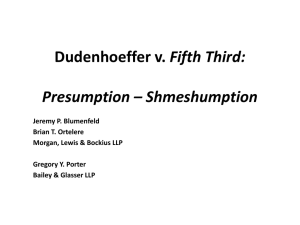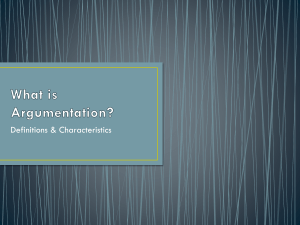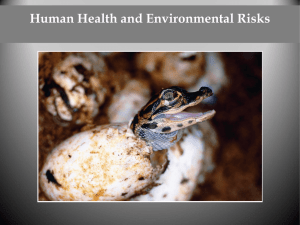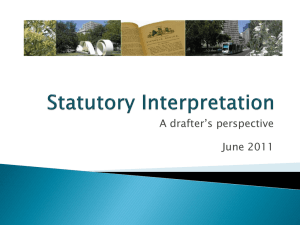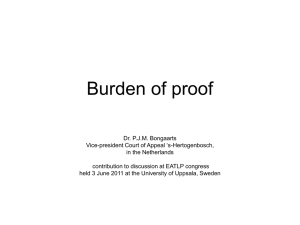Presentation (PowerPoint)
advertisement
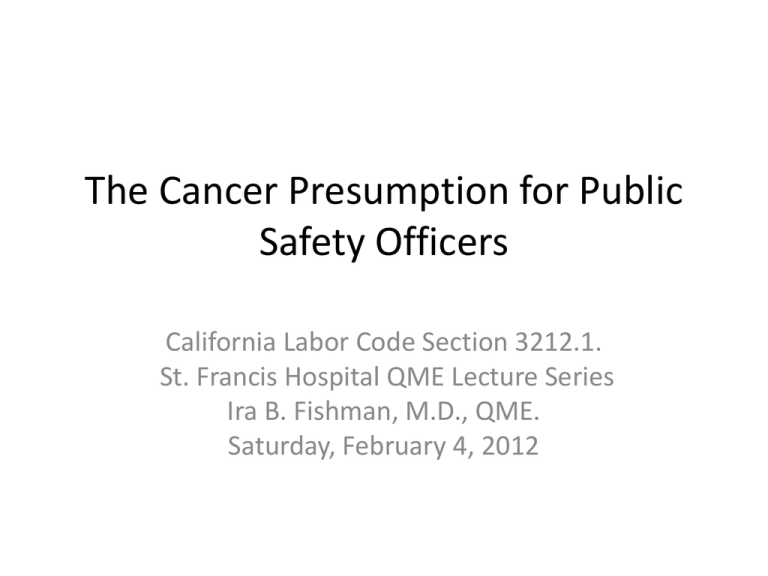
The Cancer Presumption for Public Safety Officers California Labor Code Section 3212.1. St. Francis Hospital QME Lecture Series Ira B. Fishman, M.D., QME. Saturday, February 4, 2012 THE CANCER PRESUMPTION • Like apportionment, the cancer presumption, as contained in California Labor Code Section 3212.1, is a medical legal construct that has no independent basis in scientific reality. • There does not exist a separate body of scientific literature to assist in the medical legal determination of cancer causation for the cohort to whom this section applies. THE CANCER PRESUMPTION • In other words, the cancer presumption statute is an intersection of: • • • • Political lobbying by state employees Legislative intent and action Court decisions Science but mostly to the extent influenced by the other listed factors. THE LEGAL DEFINITION OF A PRESUMPTION • A presumption in the legal sense intended is not evidence but a conclusion that the law requires to be drawn when some other fact is established. • Rather than evidence, a presumption is a legal construct that aids the judicial system in determining the facts from the evidence presented. DEFINITION OF A PRESUMPTION • Therefore, it may be erroneous to consider that a presumption is evidence and imposes on one party a higher burden of proof that is required. • On the other hand, if the plaintiff finds a reasonable link between occupational carcinogen exposures and cancer, that is enough to support a finding that the defendant has not met his or her burden to prove that there is “no reasonable link” THE CANCER PRESUMPTION The unique role of the QME in the decision making process utilizing the cancer presumption: 1. Extends beyond the standard medical reasoning that doctors use to draw scientific conclusions about disease. (See Fain case subsequent). 2. As a result, the medical legal determination of injury causation is not the same as the scientific or medical determination of causation. THE CANCER PRESUMPTION • The original Legislative intent of the Section 3212.1 was probably to acknowledge the unique burden of certain public safety employees, i.e. various categories of police officers and firefighters, in responding quickly to unexpected emergencies that exposed them to known carcinogens with or without benefit of adequate protective equipment. THE CANCER PRESUMPTION • The statute was originally conceived such that the state employed public safety officer had the burden of proving that a particular carcinogen (Usually IARC Group 1 or recognized by Director Division of Industrial Accidents, CCR Title 8, Section 330, www.dir.ca.gov/Title8/330.html ) to which he had been exposed was reasonably linked to the cancer in question. THE CANCER PRESUMPTION • The original statute, passed as AB 3011 in 1981-1982, gave the burden or proof to the worker who needed to demonstrate carcinogen exposure and a “reasonable link” between the occupational exposure and the cancer in question • No quantitative threshold was expressed in the original statute nor ever in subsequent case law THE CANCER PRESUMPTION • The phrase “reasonable link” does not appear anywhere else in the Labor Code. • Eventually, in 1994, the California Appeals Court definitely considered the legal definition of “reasonable link” in the Riverview Fire Protection District v WCAB (Smith) 23 Cal App 4th 1120 (28 Cal Reptr 2d601) 59 Cal Comp Cases 180. REASONABLE LINK • In Riverview, the Court stated that: • Two things are reasonably linked if there is a “logical connection” between them. • The worker needed to demonstrate something more than coincidence of occupational exposure and cancer. • In other words, demonstration of a “reasonable link” required more than chance association but less than the preponderance of the evidence. REASONABLE LINK • Therefore, throughout the 1980s and 1990s, the injured public safety officer with cancer was required to demonstrate convincingly to the courts a nexus between the type of cancer and occupational exposure to a known carcinogen that was alleged to have caused the cancer. • Such a burden of proof was exceedingly difficult to meet for rare cancers. PAPAN AMENDMENT • In 1999, Lou Papan, a California legislator, championed the “Papan amendment” to Section 3212.1 after a firefighter in his district was unable to demonstrate a reasonable link between his rare cardiac angiosarcoma and occupational carcinogen exposures. • From prior judicial experience, it was well known that rare cancers failed the reasonable link test because of a general lack of medical literature being available for such cancers. PAPAN AMENDMENT • To the consternation of industrial insurance carriers and municipalities, AB 539 eliminated for the injured public safety officer the “reasonable link” language previously contained in Section 3212.1. • After AB 539, it was no longer the injured worker’s burden of proof to demonstrate a reasonable link between cancer and exposure to a known carcinogen; that nexus requirement was totally removed by the State Legislature. SECTION 3212.1 • After the 1999 Papan amendment was passed, California Labor Code Section 3212.1 now read as follows: NEW SECTION 3212.1 • • • • • • • • • • • • • • • a) This section applies to all of the following: (1) Active firefighting members, whether volunteers, partly paid, or fully paid, of all of the following fire departments: (A) A fire department of a city, county, city and county, district, or other public or municipal corporation or political subdivision. (B) A fire department of the University of California and the California State University. (C) The Department of Forestry and Fire Protection. (D) A county forestry or firefighting department or unit. (2) Active firefighting members of a fire department that serves a United States Department of Defense installation and who are certified by the Department of Defense as meeting its standards for firefighters. NEW SECTION 3212.1 • (3) Peace officers, as defined in Section 830.1, subdivision (a) • of Section 830.2, and subdivisions (a) and (b) of Section 830.37, of • the Penal Code, who are primarily engaged in active law enforcement • activities. • (4) (A) Fire and rescue services coordinators who work for the • Office of Emergency Services. • (B) For purposes of this paragraph, "fire and rescue services • coordinator" means a coordinator with any of the following job • classifications: coordinator, senior coordinator, or chief • coordinator. NEW SECTION 3212.1 • • • • • • • • • • (b) The term "injury," as used in this division, includes cancer, including leukemia, that develops or manifests itself during a period in which any member described in subdivision (a) is in the service of the department or unit, if the member demonstrates that he or she was exposed, while in the service of the department or unit, to a known carcinogen as defined by the International Agency for Research on Cancer, or as defined by the director. (c) The compensation that is awarded for cancer shall include full hospital, surgical, medical treatment, disability indemnity, and death benefits, as provided by this division. NEW SECTION 3212.1 • • • • • • • • • • • • (d) The cancer so developing or manifesting itself in these cases shall be presumed to arise out of and in the course of the employment. This presumption is disputable and may be controverted by evidence that the primary site of the cancer has been established and that the carcinogen to which the member has demonstrated exposure is not reasonably linked to the disabling cancer. Unless so controverted, the appeals board is bound to find in accordance with the presumption. This presumption shall be extended to a member following termination of service for a period of three calendar months for each full year of the requisite service, but not to exceed 120 months in any circumstance, commencing with the last date actually worked in the specified capacity. NEW SECTION 3212.1 • (e) The amendments to this section enacted during the 1999 portion • of the 1999-2000 Regular Session shall be applied to claims for • benefits filed or pending on or after January 1, 1997, including, but • not limited to, claims for benefits filed on or after that date that • have previously been denied, or that are being appealed following • denial. • (f) This section shall be known, and may be cited, as the William • Dallas Jones Cancer Presumption Act of 2010. THE CONCEPT OF LATENCY • For the discussion of occupational cancer, latency is generally defined as time from the first injurious carcinogen exposure to the first clinical manifestation of cancer. • In Leach v West Stanislaus County Fire Protection District (2001) 29 Cal Workers Comp Rptr, 188,189 (Appeals Board Panel) latency for solid tumors was somewhat and arbitrarily defined as 10 years. THE CONCEPT OF LATENCY • Subsequent case law has generally continued to use the 10 year threshold for latency without much further discussion. • Faust v City of San Diego (2003) (Appeals Board en banc) 68 Cal. Comp. Cases, 1822. • City of Long Beach v WCAB (Garcia), 126 Cal.App 4th • Even though the latency for hematologic neoplasms is generally less (5-7 years), this issue to my knowledge has never been addressed by the courts subsequent to Leach. THE CONCEPT OF LATENCY • The Courts have consistently failed to consider arguments for shorter latency periods even as different circumstances may apply to individual solid cancer cases. • The 10 year cut off for latency has stubbornly persisted to the present as a rock solid method available to the defense to rebut the cancer presumption. • Law v WCAB (2003) 68 Cal Comp Cases 497. THE CONCEPT OF THRESHOLD • There are two theoretical concepts regarding the amount of carcinogen exposure required to cause cancer. • The first is the one molecule theory that postulates one molecule of exposure to a carcinogen such as benzene is theoretically sufficient to induce malignant mutation of a cell into a cancer cell which then begins reproducing and causes a cancer to develop and grow. THE CONCEPT OF THRESHOLD • The second theory postulates that there are levels below which acute and/or chronic carcinogen exposure does not cause cancer. • Public policy routinely relies on the concept of threshold to fix permissible levels of carcinogen exposure for workers. • Science seems to favor the concept that there is no safe limit of exposure to at least certain carcinogens such as benzene. THE CONCEPT OF THRESHOLD • With regard to the cancer presumption, for unclear reasons, the courts have never clearly established what is legally sufficient carcinogen exposure to cause cancer. • Perhaps this is another hidden reason for the existence of the cancer presumption; public safety officers are never prospectively followed during their careers for any determination of quantitative carcinogen exposure. THE CONCEPT OF THRESHOLD • As best as I can determine, it was initially a low level WCAB decision, the Leach case that, in addition to fixing the 10 year latency period for carcinogenesis, also concluded that the demonstration by the worker of minimal exposure to a carcinogen in the workplace was sufficient to satisfy the applicant’s burden of proof for Section 3212.1. No specific level of actual exposure needs to be demonstrated THE CONCEPT OF THRESHOLD • Not directly, but by analogy and never considered in case law to date, is the fact that the concept of minimal exposure to a carcinogen satisfying applicant burden of proof for Section 3212.1 may be contrary to Supreme Court findings in other cases that dismiss “infinitesimal” or “inconsequential” employment contribution to incapacity. FAUST v CITY OF SAN DIEGO • Faust v City of San Diego (2003) (Appeals Board en banc), 68 Cal Comp Cases 1822 definitely addressed the implications of the Papan amendment passed in 1999-2000 • To successfully litigate under Section 3212.1, the applicant must be an active police officer/firefighter as defined in beginning of 3212.1 • Must demonstrate (minimal) exposure to a known human carcinogen as defined by IARC (Group 1) FAUST v CITY OF SAN DIEGO • The cancer developed or manifested itself during the time period when the injured officer was in active service ( or depending on length of active service, for up to 60 months after last active date of service, recently amended to 120 months) • Once the injured officer has demonstrated his/her burden of proof, the cancer presumption arises and the burden of proof shifts to the employer. FAUST v CITY OF SAN DIEGO • To successfully rebut the presumption, the employer must show two things: • Evidence that the primary site of cancer has been established. • That exposure to the known carcinogen is not reasonably linked to the disabling cancer. • Therefore, when the primary site of cancer is unknown, the presumption is conclusive and cannot be rebutted. FAUST v. CITY OF SAN DIEGO • To rebut the cancer presumption, the defendant must prove that there is no reasonable link between the carcinogen and the cancer. • Merely demonstrating that there is no evidence demonstrating a reasonable link is not sufficient to rebut the cancer presumption. • Euerle v City of Santa Clara 38 CWCR 12 (WCAB Panel, 2009) CITY OF LONG BEACH v. WCAB (GARCIA) • City of Long Beach v WCAB (Garcia) (2005), 126 Cal. App 4th, 315 generally affirmed the en banc Faust decision (2003). • As opposed to other presumptions, the link may be contraverted only in a specific and limited way: proof of the cancer’s primary site and absence of reasonable link. • No reasonable link includes establishing that the latency period of the manifestation of the specific cancer excludes the exposure as the cause of the applicant’s cancer (Law, 2003) CITY OF LONG BEACH v. WCAB (GARCIA) • For rebuttal, there must be no logical connection (reasonable link)between carcinogen exposure and cancer or the possible connection is so unlikely as to be absurd or illogical. • Medical studies that show particular cancers not caused by certain carcinogens may be relevant. • Quantity or length of time of carcinogen exposure may have been too small or brief to have had a deterimental effect. CITY OF LONG BEACH v. WCAB (GARCIA) • The exact language of the Garcia Court is: • “…We agree that the burden of proof placed upon the employer is a difficult one. However, we disagree that the standard is impossible to meet…. For example, perhaps it would be possible for an employer to show that the quantity of the carcinogen to which the employee was exposed or the length of time of exposure, was too small or too brief to have any detrimental effect.” FAIN v WCAB • A recent Court of Appeal 5th district decision examined the requirement that the applicant demonstrate exposure to a known carcinogen. • In this case, not certified for publication, a police officer with over thirty four years of service was determined by an AME physician to never have been exposed to carcinogens in the workplace. • The Court of Appeals was forced to agree with the WCAB that the applicant’s burden of proof for applying the cancer presumption had not been met. • In my opinion, the AME presented an inadequate occupational history to the Court; this case is not and should not be citable. FUTURE MEDICAL LEGAL DIRECTIONS • Considering latency on an individual, case by case basis (followup to Law). • Hematologic neoplasms have different latency periods compared to solid tumors (no case law) • Can threshold actually be used to rebut the cancer presumption (suggested by Garcia) • Synergistic effect of multiple carcinogen exposures (sparsely discussed in case law) APPLYING THE CANCER PRESUMPTION AFTER RETIREMENT • The courts have uniformly concluded that the phrase “develops or manifests” was deliberately and meaningfully placed in the cancer presumption by the Legislature ( I have my doubts). • Therefore, it is sometimes possible to backdate the onset of a cancer before actual diagnosis if one can successfully argue that the applicant exhibited clinical manifestations of cancer, even if undiagnosed. • Such symptoms can then cause the first clinical manifestation of cancer to fall in the window allowed for application of the cancer presumption after retirement (Darling case) • “Window” after retirement recently extended to up to 120 months depending on length of antecedent service. APPENDIX • I have appended to these lecture notes a complete list of IARC carcinogens, Groups 1-4. • Please note that, for the purpose of discussing the cancer presumption, only Group 1 carcinogens, known to be carcinogenic to humans, are relevant as specified by Section 3212.1. • IRA B. FISHMAN, M.D., Q.M.E. • irafishmanmd.com • irafishman@irafishmanmd.com
